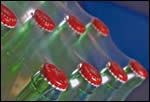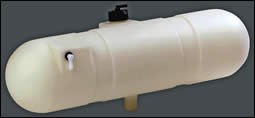K 2004 News Preview: Materials
Quite a few new polyolefins are being featured at this year’s show, with a particular emphasis on specialty PP and PE materials.
Quite a few new polyolefins are being featured at this year’s show, with a particular emphasis on specialty PP and PE materials. Also, a full slate of new engineering resins at K 2004 are weighted toward nylons, acetals, polyesters, and TPEs tailored for improved processability, aesthetics, and specialized functional properties.
Polypropylene, TPO & TPV
Borealis is introducing several new PP resins that are made in Europe but will be available in the U.S. One is RF926MO, a stretch-blow molding grade for growing OPP bottle markets. It reportedly has a much wider processing window than other PP resins.
Also new are two film resins. Borclear RB707CF (1.8 MFR) is a high-clarity blown film grade for food packaging. Borsoft SA233CF is designed mainly for use in coextrusion or blends to upgrade the impact and tear strength of PE film structures. It also provides good sealing behavior and heat resistance. A typical use is in hygiene films, where it enables downgauging of existing PE film structures by 20% to 30%.
Borealis also has eight new PP film grades for medical pouches and blister packaging. Advantages are said to include low migration of residual ingredients into medical products and liquid contents. Among them are Borsoft SD233CF and SC220CF for transparent cast and blown film, Borsoft SA233CF for translucent blown film and tubing, RD204CF and RD208F random copolymers for cast films, and RB501BF for cast and blown films. Also new are special homopolymers like HD601CF, Bormod HC905TF, and DM 55 Pharm for cast and blown films.
Two new TPOs from Borealis were developed for the bumper and rocker panels of BMW’s Series 1. They reportedly allow for easy molding of paintable Class A surfaces. Daplen EE109AE is the high-impact material in the bumper and Daplen EE340E is a high-stiffness grade for the rocker panel.
Two more new TPOs from Borealis are EE137AE and EE137HP for injection molding auto interior parts and similar demanding applications. Their scratch resistance is built into the base resin so as to minimize the need for fillers.
Basell Polyolefins is featuring Softell, its new generation of PP materials produced with its proprietary Catalloy technology. Geared to a wide range of applications from auto interiors to hygiene films, they reportedly offer new levels of softness, flexibility, and toughness. Softell resins reportedly can mimic the surface qualities of natural materials such as leather and fine fabrics. Their high flexibility is achieved without the use of plasticizers and they are said to bond strongly to other polyolefins. They can also take high loadings of a wide range of additives, from colorants to flame retardants and fillers.
Three Softell grades are currently available: CA 02 A (0.870 g/cc, 0.6 MFR) is a TPO for extrusion, calendering, and blow molding of very soft film, sheets, and squeeze bottles. Q020 F is an elastomeric TPO (0.870 g/cc, 0.6 MFR) with an extremely high rubber content and high softness. C 102 M is a cast film grade (0.900 g/cc, 6.0 MFR) for tough, transparent coextruded structures. It is said to combine transparency with high softness, very high toughness at low temperatures, and excellent compatibility with other polyolefins. It is said to optimize the post-sterilization optical and mechanical properties of coextruded medical films.
Meanwhile, Dow Plastics is showing grades of Inspire PP with 20 times higher melt strength than standard resins. And ExxonMobil Chemical is showing new developments in very soft TPVs and low-lead-content TPVs in the Santoprene family from its Advanced Elastomer Systems subsidiary.
Specialty PE resins
Borealis is introducing two new families of polyethylenes made with a single-site catalyst. They are aimed at packaging such as shrink and stretch films, food packaging, shipping bags, industrial liners, and grocery bags. Borcene PE resins mark the company’s entry into single-site, unimodal LLDPE blown and cast film resins. BorPlus bimodal PE resins for blown film are made with the company’s Borstar technology and reportedly offer superior processability.
Borealis is launching two new HDPE grades based on Borstar bimodal single-site technology and designed for beverage caps and closures, particularly for carbonated water and soft drinks. Closures of these resins reportedly exhibit outstanding ESCR and well-balanced mechanical properties.
Also new is Borealis’ BorPEX ME2510, a new grafted compound for silane-crosslinked PE pipe used in domestic hot and cold water pipes. Produced with the company’s Ambicat MB60 catalyst system, it is said to achieve silane crosslinking at ambient temperature within a few days. This saves the cost of post-extrusion treatment that is required to cure other silane-crosslinked HDPEs for pipe.
New-generation nylons
BASF is launching Ultramid A3WG10 HS Black 20560 as a low-cost alternative to high-temperature polymers. Mechanical properties of this 50% glass-filled nylon 66 after 1000 hr of heat aging at 190 C are comparable to those of high-temperature resins currently used, according to BASF. The material can be injection molded under standard nylon 66 processing conditions, avoiding the need for costly mold-heating equipment associated with high-temperature polymers.
BASF will also feature new Ultramid B3WGM24 HP, a high-productivity nylon 6 that contains 10% glass and 20% mineral reinforcement. It is targeted for large-surface-area moldings such as engine covers, which require both good melt flow and impact strength. Compared with standard nylons, the new resin exhibits 40% better flow for the same tensile strength, while impact strength and elongation at break are only 10% less than standard grades. A 30% glass-filled grade, Ultramid B3EG6 HP, has been developed for power tools.
For a paintless metallic effect, BASF’s new Ultramid A3HG7 Titanium Gray, a nylon 6 with 35% glass, is said to guarantee high color stability plus good surface finish.
BASF has also brought out three new flame-retardant grades. Ultramid B3U HF is a halogen-free, unreinforced nylon 6 for thin-wall electrical housings that require a UL 94V-0 rating. Another new development is Ultramid B3UM4, a halogen-free nylon 6 for circuit breakers. BASF uses a low-cost mineral filler while reportedly minimizing losses in mechanical performance. Also new is Ultramid A3UG5, a reinforced nylon 66 with no halogen or red phosphorus. The company says a new low-color FR additive makes it possible to formulate V-0 glass-filled nylons that are colorable.
Among several new nylon developments from DuPont is a new grade of Zytel with high hydrolysis resistance. It was developed for a cooling-system connector made by ABA of Sweden for Visteon’s new HVAC cooling system used in the 2005 Ford Mustang GT and throughout the Ford C1 platform.
DuPont (like Bayer and Rhodia) has also come out with special grades of Zytel nylon for water-assisted injection molding of automotive pipes. Hydrolysis resistance is important here, too, to prevent debonding of glass fibers from the resin matrix.
In addition, DuPont has new flame-retardant Zytel grades free of both halogen and red phosphorus. Other new grades include a new nylon 612 for abrasion-resistant linings of hoses for oil and gas exploration. Called Pipelon, the material reportedly allows faster extrusion than hoses using nylon 11 or 12 abrasion layers. Pipelon also withstands higher temperatures, and it costs less.
Rhodia is introducing new hydrolysis-resistant nylon 66 grades that have been approved by regulatory authorities in Germany and the U.K. for drinking-water applications. Technyl A 218W V30 and Technyl A216 V30 boast high strength and stiffness in hot aqueous environments, high impact and chemical resistance, and excellent surface finish.
Rhodia also will launch two Technyl RTM nylon grades for rotomolding. The materials are said to unlock the potential to produce large parts in one of the most widely used engineering plastics. Commercial grades include Technyl RTM C207L, a natural nylon 6 that is heat and light stabilized, and Technyl RTM C207, a heat-stabilized black nylon 6. The materials are targeted for water or fuel tanks, body parts, construction panels and ducts, housings, and acoustic insulation.
Acetals love hot diesel
At the top of DuPont’s news in acetals is Delrin 560HD, which resists hot diesel fuel much better than standard acetals. New low-emissions diesel engines pressurize the fuel and raise its temperature. Test specimens of the new grade reportedly outperformed other acetals evaluated by DuPont, including those offered by other suppliers specifically for hot-diesel uses. After 336 hr at 100 C, Delrin 560HD retained 98% of its original mass while only 20% of a standard acetal remained. Potential applications include fuel-pump reservoirs, fuel senders, connectors, and tank flanges.
To combat VOCs and odors emitted by plastics in auto interiors, DuPont has also developed a new acetal copolymer to help auto makers eliminate or reduce these smells. The company has a range of Delrin grades that are below the German VDA 275 limit—less than 10 ppm—and is introducing two ultra-low-emission grades, Delrin 460E and Delrin 1260E, which meet various General Motors, Ford, and DaimlerChrysler specifications.
Another interesting development is a structural bonding technology that overcomes acetal’s natural resistance to adhesion to other plastics. This is a processing technology whereby the two molten materials to be bonded are brought together in the mold on either side of a nonwoven, microporous fabric. This thin veil is penetrated by both melts and acts as a mechanical tie layer. Low-pressure injection is used for initial filling, so as not to damage the veil, then high pressure is applied at the end. The first application, in advanced development, is a fuel-system component of acetal and HDPE. Soft-touch parts of acetal and a TPE are another possibility.
In addition, DuPont has new Delrin KM, which contains chopped Kevlar aramid fiber. The abrasion-resistant compound is used in beverage conveyor belts that are self-lubricating and long lasting.
Polyesters run faster
BASF will unveil rheology-modified Ultradur PBT grades, which are said to flow at least twice as far as comparable standard grades. The key to the flow enhancement is nano-particles of an additive in the size range of 50 to 300 nm. The additive, along with the special way it is incorporated, reportedly causes a big drop in viscosity—about 50% for an Ultradur with 30% glass reinforcement. Initial grades are Ultradur B4300 G2, G4, and G6 with 10%, 20%, and 30% glass, respectively.
Two interesting application developments with PBT will be highlighted by DuPont. One is auto headlamp reflectors that use a small degree of foaming (2%) to enhance dimensional stability. The high-gloss surface required for metalizing is retained, thanks to a combination of optimized mold temperature (around 95 C) and very fast injection.
The other news is that a Belgian company, Orang Tiga, is the first in the world to make use of powder coating to decorate PBT. The lever of the company’s Brani belt is molded of DuPont Crastin PBT, which is coated a shiny black with DuPont Envex thermosetting polyester powder. The lever was formerly made of chrome-plated Minlon mineral-reinforced nylon. The grade of PBT is modified for better adhesion to the coating. Powder coating of thermoplastics, still in its infancy, yields a thick, scratch-resistant coating without generating VOCs or other pollution. Although Envex is more expensive than chrome plating, productivity is said to be 40% higher. DuPont sources say several projects are in development and that there is lots of interest from the U.S. appliance industry.
DuPont also made its Shine-E Rynite PET, first announced at NPE 2003, available for sampling this July. This proprietary non-glass-reinforced PET is said to offer both high gloss and on-line E-coat paintability for auto exterior body panels. It is now also being evaluated for heat-resistant appliance parts such as oven door handles, toaster housings, and motor housings. Electrically conductive versions for electrostatic dissipation are also in development.
More engineering resins
PPS is now blow moldable, according to Ticona, which developed a special grade, Fortron 1115L0, together with blow molding machine maker SIG Kautex. The glass-filled material was developed to produce turbocharger air pipes.
In polycarbonate, Bayer MaterialScience will introduce six new Makrolon special-effect colors in its Fantasia program that are based on market-trend data from the design and fashion industries. They are Silverado, a deep metallic silver; Black Starlight, a glossy black with metallic flakes that provide a 3D effect; Fade-to-Black, a metallic color that shifts between green and black, depending on viewing angle; Heart’s Desire, a high-definition metallic red; Titanium metallic gray; and White Marble.
In styrenics, newly formed Lanxess, a Bayer subsidiary, is introducing Triax DP 3161, a new ABS/nylon alloy that can be coated without using conductive primers. It is aimed at auto fuel-tank caps, decorative strips, mirror housings, and handles for tailgates and trunk lids.
Victrex will show its new Ultra-High-Purity PEEK for clean-room, pharmaceutical processing, and analytical chemistry applications. Victrex will also present new PEEK-HT film for applications demanding high heat resistance.
Innovative TP elastomers
GLS Corp. will unveil its Versaflex OM 6100 series of TPEs for nylon overmolding. They are claimed to provide a superior bond to most types of standard and modified nylons. Other features include a soft feel (60 to 75 Shore A), dull matte finish, and excellent colorability. Targets include lawn and garden tools, hand and power tools, kitchenware, housewares, and sports and leisure goods.
DuPont is developing novel modified powder forms of its Hytrel copolyester TPE for slush molding of auto dashboard covers to replace PVC. The soft Hytrel skin would be backed by a Hytrel foam layer and mounted on a rigid support of Crastin PBT—creating the first all-polyester dashboard structure, which could be recycled without separating its components.
Incidentally, DuPont says foamed Hytrel films, which have a silky feel, are being laminated to PBT for several concept chairs being developed by the furniture industry.
Related Content
The Fundamentals of Polyethylene – Part 1: The Basics
You would think we’d know all there is to know about a material that was commercialized 80 years ago. Not so for polyethylene. Let’s start by brushing up on the basics.
Read MoreFundamentals of Polyethylene – Part 5: Metallocenes
How the development of new catalysts—notably metallocenes—paved the way for the development of material grades never before possible.
Read MorePrices of All Five Commodity Plastics On the Way Up
Despite earlier anticipated rollover in prices for most of the volume commodity resins, prices were generally on the way up for all going into the third month of first quarter.
Read MorePrices Up for PE, PP, PS, Flat for PVC, PET
Trajectory is generally flat-to-down for all commodity resins.
Read MoreRead Next
For PLASTICS' CEO Seaholm, NPE to Shine Light on Sustainability Successes
With advocacy, communication and sustainability as three main pillars, Seaholm leads a trade association to NPE that ‘is more active today than we have ever been.’
Read MoreSee Recyclers Close the Loop on Trade Show Production Scrap at NPE2024
A collaboration between show organizer PLASTICS, recycler CPR and size reduction experts WEIMA and Conair recovered and recycled all production scrap at NPE2024.
Read More















